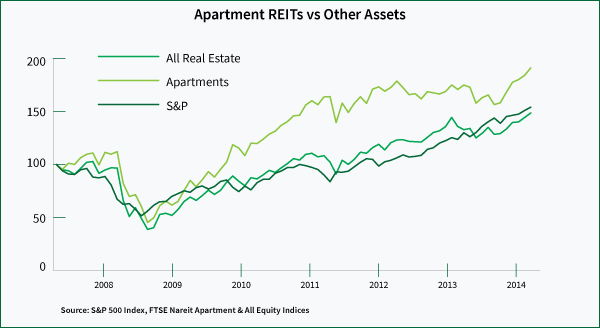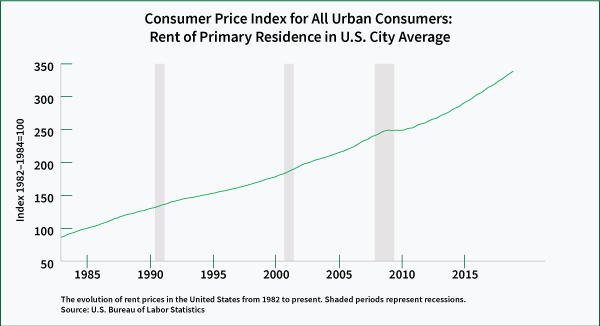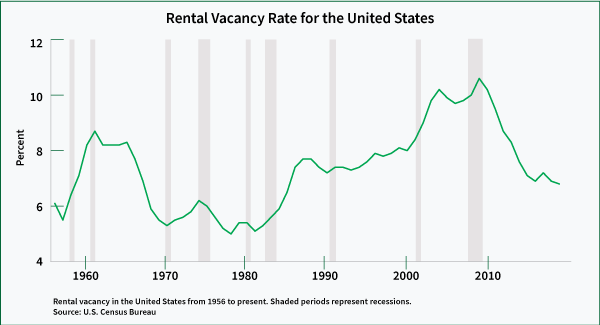As the coronavirus (COVID-19) continues to spread, overwhelming our healthcare system, choking the global supply chain and rattling the world’s financial markets, there has been a lot of discussion about a pending recession.
While it is impossible to predict exactly what impact COVID-19 will have on the U.S. economy in the short or long term, it is safe to say that investors will be reassessing their portfolios and determining where to move their capital, both in terms of growing wealth as yields tighten, and also in terms of maintaining wealth while just about every investment has seen a decrease in value.
One asset class that historically is seen as more resilient in a recession is multifamily real estate. In this article, we explore multifamily’s performance in recessions and why it may be a more stable investment choice.
Are we in a recession?
On Tuesday, March 17, Oxford Economics, a global forecasting and quantitative analysis company, bluntly declared that “the US economy is in a recession.” While a slowdown is certainly occurring due to the COVID-19 outbreak, it is of paramount importance to understand what a recession is.
There are various definitions of a recession, but the most commonly accepted one is two consecutive quarters of negative economic growth. As a result of COVID-19, the stock market has fallen sharply, but it cannot be definitively known if the U.S. economy will fall into a recession until two consecutive quarters have passed and the actual economic statistics are revealed to reflect negative economic growth.
Currently, the most relevant data available is the stock market, but the economy and the stock market are not one in the same. The stock market represents the forward-looking performance of publicly listed companies, which make up a significant part of the overall U.S. economy. Since the outbreak of COVID-19, the value of the S&P 500, an index comprised of 500 major public companies, fell more than 30% from its high on February 19.
The Federal Reserve has taken multiple actions to provide liquidity to the markets and mitigate the economic impact of the outbreak, and Congress is preparing a stimulus package that will help Americans meet financial obligations during these unprecedented times. The hope is that although the virus shocked the financial system, these moves will unfreeze credit markets and allow the economy to potentially regain solid footing.
Why does multifamily investment tend to be more stable in recessions as compared to other investments?
The simple answer is, during a recession, people are likely to save cash and cut spending. The retail, office and hospitality sectors may be adversely impacted as people stop visiting stores for discretionary goods and services, companies shutter, and people travel less often. But people will continue to need a place to live.
During a time where liquidity is important, most people will not look to buy homes, which is a major purchase. In fact, it can be more challenging for people to qualify for mortgages during a recession as lenders typically originate less loans due to liquidity constraints and more carefully scrutinize mortgage loan applications. Therefore, it’s likely that the share of renters will increase during these uncertain times.
As the demand for apartments increase, rents increase as well (albeit not as quickly as during rising economic conditions.)
The multifamily sector also has certain features that help it standout against other asset classes. Multifamily buildings typically feature larger tenant bases than other asset types, so individual vacancies do not have the material impact on revenue as they do with retail and office properties. Moreover, the short-term nature of leases in apartments allow owners to be more flexible to react to changing economic conditions. They can quickly adjust to short-term vacancies, but can also limit the long-term impact on revenue as leases entered into during recessions can be quickly renegotiated during the recovery.
Finally, in regards to COVID-19 specifically, many multifamily tenants are likely to stay put due to health and economic uncertainties.
What are the lessons from the Great Recession and other downturns?
A careful and diligent study of multifamily’s performance during recessions in past market cycles can give us an informed perspective of how multifamily may perform in the future.
The collapse of the financial system during the Great Recession, which began in December 2007 and lasted until June 2009, froze credit and spending, impacting consumer and investor confidence.
During this time, apartment Real Estate Investment Trusts (REITs) experienced volatility as much as other investments, but quickly rebounded. Over the subsequent five years after the Great Recession, apartment REITs outpaced other commercial real estate asset classes and the S&P 500.

Looking more widely over the course of four decades, residential rents throughout the U.S. have generally risen each year — even during recessions, according to the U.S. Bureau of Labor Statistics. The one exception is the period following the Great Recession from 2009 to 2010, when the pace of rent growth was flat. But following that year, rents quickly continued their ascent.
Rents make up the bulk of the gross revenue for apartment buildings, so as rents rise, so does gross revenue. For building owners with fixed-rate mortgages and stable expenses, that would mean it’s possible for net operating incomes to increase as well, which ultimately equals rising property values.

Another measure of the performance of multifamily investments is the vacancy levels in the industry. Rental vacancy in the U.S. has generally increased during past recessions, but not dramatically. It’s widely noted that the Great Recession was the most financially devastating period since the Great Depression in the 1930s, and even then, the vacancy rate for U.S. rentals only peaked at approximately 10.6% in 2009 before falling steeply in the following years, according to U.S. Census Bureau information. Additionally, certain markets suffered far less dramatic falls in vacancy rates during the Great Recession, which demonstrates that there can be good opportunities in all market environments as long as the market fundamental remain strong.

Conclusion
At ArborCrowd, we continue to monitor the rapid economic changes occurring during these unprecedented times. As in all periods of uncertainty, there is also opportunity. Multifamily investment is one such possible opportunity. People will need a place to live and the demand for quality, workforce housing remains strong. We are committed to identifying opportunities that exhibit strong fundamentals. Although there are risks involved in multifamily investment as with any other asset class, history has shown us that the performance of multifamily assets in a recession tends to be more stable and resilient than other investments.
